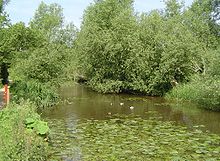Abingdon Abbey

Abingdon Abbey (also St. Mary's Abbey ) was a Benedictine monastery in Abingdon , Oxfordshire .
history
The abbey was supposedly founded in 675 by Cissa , Viceroy of Centwine and King of the Saxons , or his nephew Hæha in honor of the Virgin Mary and initially offered space for 12 monks.
With the support of several West Anglo-Saxon kings, their importance and financial stability grew. It was destroyed by the Vikings at the time of King Alfred the Great . There is a collection of 136 articles with rights granted to the monastery by various Anglo-Saxon kings. The history of the monastery was recorded in the Historia Ecclesie Abbendonensis in the 12th century .
Among the abbots, the future bishop of Winchester Æthelwold (around 904–984), Faritius († 1117), also known as Faricius, and Richard von Hendred played a prominent role. The last abbot, Thomas Pentecost , also known as Rowland, was one of the first to accept the king's ecclesiastical supremacy .
building
There are no remains of the abbey church, only some ruins of arches in the 'Abbey Gardens', which were probably not built as a replica in the historical style until 1920 . There are, however, listed monastic buildings such as the monastic camera building ( Abbey Exchequer ), the long half-timbered gallery ( Long Gallery ), the monastic bakery, the monastery gate ( Abbey Gateway ), the Johanneshospiz ( St John's Hospitium ) and the Nicolaikirche ( Church of Saint Nicolas ). One of the historic open chimneys was removed from the monastery and can still be seen in Lacies Court today.
Web links
Individual evidence
- ↑ Abingdon Abbey booklet. Vale of White Horse District Council, Oxfordshire, UK, archived from the original on April 11, 2012 ; accessed on February 5, 2012 .
- ↑ Abingdon Abbey . Royal Berkshire History , UK. Retrieved February 5, 2012.
- ↑ See Historia Ecclesie Abbendonensis (English).
Coordinates: 51 ° 40 ′ 14 " N , 1 ° 16 ′ 31" W.

